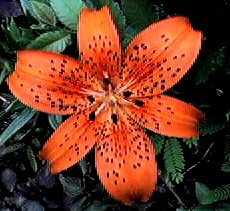
Tiger Lily
Family: Lily
Size: 4 inch
Date: Late May
Wild Lily (Lilium philadelphicum)

Also called "red lily" or erroneously the garden "tiger lily," this beautiful native plant sometimes blooms profusely during late June in the native grasslands of North Dakota. Red lily has a huge range, being found in open areas from Quebec to British Columbia and southward. The deep orange or red flowers of this perennial are up to three inches wide with black spots on the bases of the petals and sepals. The narrow leaves are about two inches long. Stems may be up to two feet tall from white underground bulbs. In our area, red lily is found in moist, low-lying prairie that is not heavily grazed or regularly mowed for hay. As land use becomes more intense and use of herbicides increases, red lily is becoming increasingly more difficult to find and probably should not be picked or dug up, lest we lose it from our flora. The bulbs of this plant were boiled and eaten like potatoes by native Americans. The lily family (Liliaceae) also includes the edible onion, garlic, and asparagus, but also contains poisonous plants such as death camas and hellebore.
Lily is the classical Latin name for these plants and the specific name philadelphicum means "of Philadelphia" in botanical Latin. Red lily was first described by the famous Swedish botanist Carl von Linne (Linnaeus) in 1753. Botanists consider Linnaeus' Species Plantarum to contain the first scientifically acceptable descriptions of plants.
Northern Prairie Science Center
NPSC Home | Biological Resources | Help & Feedback
![]()
Lilium lancifolium. The TIGER LILY is often grown in the flower garden but in the Orient it is cultivated for its edible bulb. In fact when grown as a root crop the Chinese actually pick off the flower buds to stimulate the production of larger bulbs. All other members of this genus also produce edible bulbs, though these can often have a bitter flavour. When baked, lily bulbs taste rather like potatoes. One word of warning with this particular species - although tolerant of virus disease, it can often act as a carrier of these diseases and so becomes a vector infecting other species. It is therefore wise to either grow this species well away from your other lilies, or to avoid growing the other species if you grow this one. The plant is easily propagated by means of bulbils that form in the leaf axils. Simply pot these up in the summer when they part easily from the plant and then plant them out in the spring 18 months later. Allow some of the bulbils to fall to the ground to see of the plant will maintain itself without your help.
![]()
 Wildflower
Seed For Sale
Wildflower
Seed For Sale